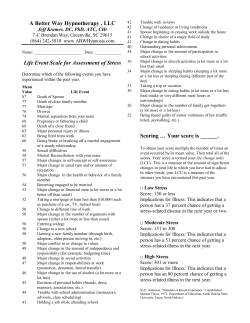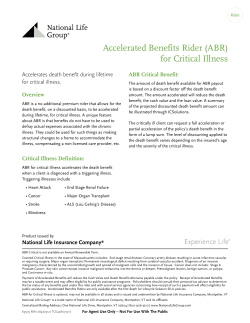
When "Early Mobility" is Not the Answer: Challenges to the
When "Early Mobility" is Not the Answer: Challenges to the Effectiveness and Appropriateness of PT Intervention for Patients with Critical Illness Amy Pawlik, PT, DPT, CCS Sarah Harrison, PT, DPT Saturday, February 7, 2015 Objectives 1) Identify medical conditions that may limit the effectiveness of physical therapy intervention in patients with critical illness 2) Identify medical conditions that may limit the safety and appropriateness of physical therapy intervention in patients with critical illness 3) Discuss strategies to initiate challenging conversations with the medical team regarding a patient's response, or lack of response, to physical therapy intervention Challenges to PT Intervention in Critical Illness 2 Why discuss this? • Long term sequelae of critical illness • Growing body of evidence supporting safety and effectiveness of intervention • Barriers to our intervention Challenges to PT Intervention in Critical Illness 3 A problem… Challenges to PT Intervention in Critical Illness 4 Solutions! Challenges to PT Intervention in Critical Illness 5 Barriers? Challenges to PT Intervention in Critical Illness 6 Safety? Expert consensus and recommendations on safety criteria for active mobilization of mechanically ventilated critically ill adults. Critical Care 2014, 18:658 doi:10.1186/s13054-014-0658-y • Great article that gives some guidance to when mobilizing a patient in bed or out of bed is recommended, should proceed with caution or may be contraindicated • Very comprehensive considering vent settings, line presence, hemodynamic stability, etc • However, does not consider those factors that may negatively impact the effectiveness of intervention Challenges to PT Intervention in Critical Illness 7 Hodgson, CL, et al. Expert consensus and recommendations on safety criteria for active mobilization of mechanically ventilated critically ill adults. Critical Care 2014, 18:658 doi:10.1186/s13054-014-0658-y Challenges to PT Intervention in Critical Illness 8 Hodgson, CL, et al. Expert consensus and recommendations on safety criteria for active mobilization of mechanically ventilated critically ill adults. Critical Care 2014, 18:658 doi:10.1186/s13054-014-0658-y Challenges to PT Intervention in Critical Illness 9 Stop signs for Effectiveness? Your Intervention May Not Be Working Because…??? Challenges to PT Intervention in Critical Illness 10 Clarification “Early mobility/mobilization” versus Physical therapy intervention Rehabilitation in the ICU Physical therapy intervention in critical illness Challenges to PT Intervention in Critical Illness 11 What to expect • Series of case studies that address a few specific medical issues • Some of the issues that may be a factor in rehabilitation • Not all answers→initiate discussion on how we can begin to approach some of these topics Challenges to PT Intervention in Critical Illness 12 Possible barriers to effectiveness of PT intervention • Nutrition • Endocrine • Myopathy/polyneuropathy • Phos/Calcium/Magnesium • Inflammatory process • Worsening blood gases, mixed venous • Mental status • And more! Challenges to PT Intervention in Critical Illness 13 Case Studies • Nutrition • Endocrine • Safety Concerns Presentation Title Here | 14 Endocrine as a barrier? • Mr Smith • 64 yo male, IPF Challenges to PT Intervention in Critical Illness 15 Patient, Mr. Smith November 2013 1 2 3 4 5 6 7 8 9 10 11 12 13 14 15 16 17 18 19 20 21 22 23 Single Lung Transplant VV ECMO VV ECMO 24 25 26 27 28 29 30 RN note: moving all extremities Challenges to PT Intervention in Critical Illness 16 December 2013 1 2 3 4 5 6 7 NO weaned, sedation lightened PT and OT initial evaluation “no active movement extremities” 8 9 10 11 12 13 14 15 16 17 18 19 20 21 22 23 24 25 26 27 28 29 30 31 Challenges to PT Intervention in Critical Illness 17 We tried everything!!!!!!! • Mobilization • Bed to Chair • NMES • Weightbearing • Tactile stimuli • Increased frequency of sessions • Decreased frequency of sessions • Considered many possible medical explanations in an effort to help with frequency, intensity, rehab prognosis, etc. Challenges to PT Intervention in Critical Illness 18 The team tried everything!!!! • Head CT 12/6-infarct, occipital lobe • EEG 12/6-marked encephalopathy • Spine CT-normal • Nutrition-tube feeds started early • Normalize Na, blood glucose, • MORE PT and OT!!!!!! Challenges to PT Intervention in Critical Illness 19 January 2014 5 12 6 7 1 2 3 4 8 9 10 11 NCV/EMG→ Myopathy “Will start growth hormone” “Will add testosterone ” 13 Trace wrist, shoulder movements noted with OT 14 Trace knee extension L, 2-/5 knee extension R 15 16 17 18 19 20 21 Active movement B elbow flx/ext, hip rotators 22 23 24 25 26 27 28 29 3-/5 knee extension B 30 31 “TSH elevated, will discontinue synthroid” Challenges to PT Intervention in Critical Illness 20 EMG • Revealed myopathy not polyneuropathy Challenges to PT Intervention in Critical Illness 21 Endocrine Review • Various glands throughout body release hormones→specific effect on cells and organs • Maintains homeostasis with neural system: slower but longer duration • 5 general functions – – – – – Differentiation of reproductive and CNS of developing fetus Simulation of sequential growth and development during childhood/adolescence Coordination of male and female reproductive systems Maintenance of optimal internal environment Initiation of corrective and adaptive responses during emergencies Challenges to PT Intervention in Critical Illness 22 Hypothalamic Control Hypothalamus Anterior Pituitary TSH Thyroid T3 & T4 ACTH Adrenals Cortisol Aldosterone Posterior Pituitary Prolactin Other tissues Norepinephrine GH FSH LH Testis Ovaries Testosterone Estrogen ADH Kidney Oxytocin Uterus Uterus Epinephrine Challenges to PT Intervention in Critical Illness 23 Response to stress • Universal Response-FIGHT or FLIGHT-Sympathetic Nervous System – Response • CO increase • RR increase • Blood flow to brain and skeletal muscle – Activation of the hypothalamic-pituitary axis • Adrenal Cortex – Cortisol » Glucose increase-regulates metabolism of proteins, carbs, lipids » Energy-assists with increasing availability of amino acids to heal damaged tissues (delays anabolism) » Inflammation-inhibits (can cause poor wound healing) – Aldosterone » Intravascular fluid retention • Adrenal Medulla – Catecholamines increase (ionotropic and vasopressor response) » Heart-rate and force » Peripheral-increases BP » Glucose-increases liver and skeletal glycogenolysis Presentation Title Here | 24 Acute vs Prolonged response • Acute Illness – Cortisol remains elevated as compared to normal subjects • Prolonged critical illness (>10 days of ICU support) – Reduced stimulation over time of cortisol – Prolonged hypercortisolemia can lead to: • Increased risk of infection • Impaired wound healing • Prolonged catabolism • myopathy Presentation Title Here | 25 Growth Hormone • Purpose • Limitations to production • Effects of deficit Challenges to PT Intervention in Critical Illness 26 Hyperthyroid • Purpose • Limitations to production/Elevated levels • Effects of deficit Challenges to PT Intervention in Critical Illness 27 Testosterone • Purpose • Limitations to production • Effects of deficit Challenges to PT Intervention in Critical Illness 28 Lessons Learned Could this case have been managed differently? – – – – – Awareness of impact of critical illness on endocrine function Suggestion to team of other possible lab tests? Achievable goals based on prognosis related to CIM Achievable goals based on prognosis related to endocrine dysfunction Utilize additional outcome measures to better show progress/lack of progress Would he have had a different outcome? Challenges to PT Intervention in Critical Illness 29 Earlier PT and OT intervention? Fan, et al. Physical complications in acute lung injury survivors: A twoyear longitudinal prospective study. Crit Care Med. 2014;42(4):849-59. • 222 survivors of ALI • Multicenter, prospective study. Longitudinal follow-up at 3, 6, 12, 24 months • Extremity, hand grip and respiratory muscle strength assessed; anthropometrics; 6MWT distance; SF=36 QOL • Duration of bedrest was associated with decreased strength and function through 24 months of follow-up • Cumulative doses of systemic CS and NMB were not associated with weakness Presentation Title Here | 30 Other Considerations Why else may he have been performing poorly? Why else may he have started making recovery? • Infection, SIRS, sepsis • anoxia • Medication, medical treatments • Psychological state • Psychological state • Fluid overload • Other factors? • Steroid induced myopathy • Critical illness myo/neuropathy • Immune suppression • Inadequate nutrition Challenges to PT Intervention in Critical Illness 31 Nutrition as a barrier? Critically ill already have an increased metabolic rate with muscle wasting as a known complication 1, 2, 3 Increasing evidence to support early physical therapy in the ICU setting Minimal evidence looking at the impact of poor nutrition on patient’s ability to participate in PT/OT Does inadequate nutrition impact a patient’s ability to progress with PT? Should prescription of therapy intervention be adjusted in a mal/undernourished patient? Challenges to PT Intervention in Critical Illness 32 Purpose Nutritional status may be considered if a patient has plateaued or is declining despite physical therapy intervention. Challenges to PT Intervention in Critical Illness 33 Review of Terms • Metabolism – Catabolism: breaking down cell components as a source of energy – Anabolism: building new cellular components • Catabolic state: Loss of lean body mass and muscle wasting • Resting (Basal) Energy Expenditure (REE) – Strict resting state, no stimulation – kJ per hour / kg body mass – Multiplied by a stress/activity factor to estimate nutritional needs in the critically ill Challenges to PT Intervention in Critical Illness 34 Starvation vs. Stress Starvation Response ↓ REE, ↓ metabolic demand muscle mass preserved Stress Response ↑ REE Increased energy requirements ↑ metabolic demand → Catabolic state → Skeletal muscle breakdown Challenges to PT Intervention in Critical Illness 35 Markers of Nutritional Status • BMI – Nutritional assessment/need • Albumin (3.5-5.7g/dL) – Marker of long-term nutrition status (>3 weeks) – Can fluctuate based on fluid, not reliable • Prealbumin (Transthyretin/TTR: 21-41mg/dL) – Good short-term marker of nutrition status – Correlates with ICU/hospital LOS 9 – Predictive of outcome in critically ill patients (mortality) 9 • C- Reactive Protein (<5mg/L) – Inflammatory marker – Inverse relationship with Prealbumin Challenges to PT Intervention in Critical Illness 36 Literature Review • Energy cost significantly increased with active exercise during early Physical Therapy in critically ill population – REE correlated with CRP (p=0.004) • Premorbid nutritional status affects outcome • Enhanced PT and nutrition rehab package trended toward increased activity and caloric/protein intake • Muscle wasting occurs despite adequate nutrition • Optimal amount of nutrition delivery generally unknown • Also significant risks associated with overfeeding – Refeeding syndrome – electrolyte imbalances Challenges to PT Intervention in Critical Illness 37 Subject • 46yo female admitted from rehab with hematemesis • found to have GI bleed and respiratory failure requiring intubation and subsequent tracheostomy • PMH: pulmonary veno-occlusive disease leading to pulmonary HTN, right HF • s/p bilateral lung transplant at UCMC 25 days ago – transferred to rehab for 5 days prior to readmission – respiratory, kidney, liver involvement related to illness • At d/c to rehab was min A to walk 200ft. Challenges to PT Intervention in Critical Illness 38 Participation in PT/OT • Evaluated by PT/OT on day 3 • Able to mobilize with mod A, take steps • Seen for 70 PT sessions over 140 days – Additional 43 attempted sessions • Progressive decline in activity tolerance • Progressive decline in functional ability • Why spending more and more time in therapy and getting poorer results? Challenges to PT Intervention in Critical Illness 39 Hospital Course • Body composition • – BMI 17.9 (baseline 19.6) – 108lbs 75lbs by day 20 Surgeries & procedures requiring NPO/hold feeds – 6 surgeries (admission days 8-36) – 5 procedures (admission days 2-57) • Inability to tolerate tube feeds • – Ileus – C. difficile – Emesis – Ascites, abdominal distension Total 42 days of zero intake over hospitalization • Additional 23 days with less than 200 ml intake – goal 60-85ml per hour! Challenges to PT Intervention in Critical Illness 40 Modes of Nutrition Delivery Challenges to PT Intervention in Critical Illness 41 Correlation? • Looked at whether nutritional status correlated with functional ability – Looked at nutrition markers however not enough information to draw a correlation • Admission Albumin • CRP as high as • Pre-albumin as low as 5.1 61mg/L 12mg/dL – Looked at volume of enteral feeds, TPN Challenges to PT Intervention in Critical Illness 42 Enteral Feeds 2500 2000 Volume (ml) 1500 1000 500 0 0 20 40 60 80 100 120 140 160 Hospital Days TPN Challenges to PT Intervention in Critical Illness 43 Functional Status Score for the Intensive Care Unit • FIM not sensitive enough, converted to FSS-ICU • Provides measurement of change with well-established scale • 5 domains (1, dependent – 7, independent as in FIM): • – Rolling – Supine to sit – Unsupported sitting – Sit to stand – Gait Total possible score 35 Challenges to PT Intervention in Critical Illness 44 FSS-ICU scores 25 20 Score (35 total) 15 10 5 0 0 20 40 60 80 100 120 140 160 Hospital Days Challenges to PT Intervention in Critical Illness 45 Function + Nutrition FSSFSSICUICUscore score Nutrition NutritionIntake Intake 25 20 15 10 5 0 0 20 40 60 80 Hospital Days 100 120 140 160 Lessons Learned Could this case have been managed differently? – – – – Awareness of increased baseline energy needs Achievable goals based on prognosis related to nutrition Utilize additional outcome measures to better show progress Decrease therapy duration/frequency during times of high catabolism, minimal/no nutrition supplement Would she have had a different outcome? Challenges to PT Intervention in Critical Illness 47 Other Considerations Why else may she have been performing poorly? Why else may she have started making recovery? • Infection, SIRS, sepsis • Medication, medical treatments • Bleeding, low hemoglobin • Fluid status, hematology • Psychological state • Psychological state • Fluid overload • Other factors? • Steroid induced myopathy • Critical illness myo/neuropathy • Immune suppression Challenges to PT Intervention in Critical Illness 48 Take Home Messages-Changing the way we practice? • Multi-disciplinary approach is key • Question why your patient is not progressing, could nutrition status be a factor? – Correlate with CRP level for marker of REE – Prioritization of patients • Alter treatment duration, intensity • Plan of care, goals should reflect expectations based on whole patient picture, including nutritional status Challenges to PT Intervention in Critical Illness 49 Changing the way we practice? • Communicate with your Registered Dietician • Participate in multi-disciplinary Rounds • Encouraging adequate intake as part of PT/OT intervention (when appropriate) • Minimize holding tube feeds during therapy sessions • Help nursing weigh the patient when indicated to optimize calculation of nutritional need • Areas in EPIC to find more info on nutritional status: – Progress notes: FASTHUG assessment – Adult Nutrition tab in Doc Flowsheets – I/O tab in chart Challenges to PT Intervention in Critical Illness 50 Opportunities for Future Research • Collaborative research with dietary/GI on metabolic demand with early physical/occupational therapy • Do pre-albumin, CR-P levels impact a patient’s ability to participate/progress with therapy? Challenges to PT Intervention in Critical Illness 51 Finding the information Finding the information Finding the information Changing the way we practice Some other causes of weakness • Hypophosphatemia – 70% of patients mechanically ventilated in ICU – Signs and symptoms • Weakness (mimics critical illness myopathy) • Difficulty weaning from ventilator • Hypomagnesmia – 20% of patients in ICU – Signs and symptoms • General muscle weakness • Tremors • Ventricular arrhythmias • Magnesium is not routinely analyzed Hypermagnesmia – Signs and symptoms include muscle weakness Challenges to PT Intervention in Critical Illness 56 A word on safety • 55 yo female • Admitted with IPF-progressing hypoxia • Placed on VV ECMO, R IJ Annals of Thoracic Medicine. 2013;8(3) Challenges to PT Intervention in Critical Illness 57 • PaO2 50 • SpO2 86% • Max Pressors • Max ECMO • Sit up at edge of bed???? Challenges to PT Intervention in Critical Illness 58 How do we know • What’s the problem? • Can you do anything about it? Body Structure/ Activity Function (Functional (Impairment) Limitation) Pathophysiology Treatment Technique/ PT Intervention? Challenges to PT Intervention in Critical Illness 59 Considerations • Spectrum of support – Maxed? – Supplemental O2, BP, vent support, pressors, NO • How beneficial will the session be for the patient – Mental status? – Current level of function Challenges to PT Intervention in Critical Illness 60 Communication • Discussions with medical team • Documentation Challenges to PT Intervention in Critical Illness 61 References Cherry-Bukowiec JR. Optimizing nutrition therapy to enhance mobility in critically ill patients. Crit Care Nurs Q. 2013;36(1):28-36. Weber-Carstens S, Schneider J, Wollersheim T, et al. Critical illness myopathy and GLUT4: Significance of insulin and muscle contraction. Am J Respir Crit Care Med. 2013;187(4):387-96. Couillard P, Wijdicks EF. Flaccid quadriplegia due to thyrotoxic myopathy. Neurocrit Care. 2013. Epub ahead of print. doi: 10.1007/s12028-013-9940-0. Ardalan MR, Ghabili K, Mirnour R, Shoja MM. Hypothyroidism-induced rhabdomyolysis and renal failure. Ren Fail. 2011;33(5):553-4 Koch S, Wollersheim T, Bierbrauer J, et al. Long term recovery in critical illness myopathy is complete, compared to polyneuropathy. Muscle Nerve. 2014;Jan 10. doi: 10.1002/mus.24175. Elijah I, Branski LK, Finnerty CF, et al. The GH/IGF-1 system in critical illness. Best Pract Res Clin Endocrinol Metab. 2011;25(5):759-67. Challenges to PT Intervention in Critical Illness 62
© Copyright 2025









